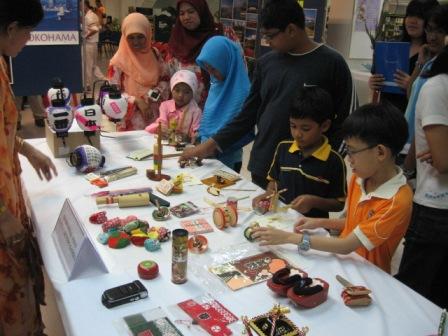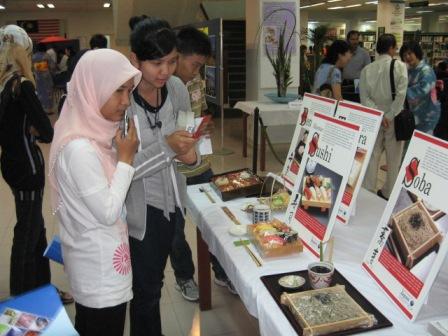|
Culture
Japan Festival 2008 in Ipoh, Perak
The Japan Festival 2008 in Ipoh, Perak, was held on Saturday, October
18, 2008 from 1200 hrs to 1500 hrs, at Perak State Public Library.
During the 3-hour programme, the participants from all walks of
life were introduced to Japanese flower arrangements, art of paper
folding, traditional toys and they also had a chance of wearing
Japanese summer wear, yukata.
During the event, participants were given Explore Japan magazines
and documentary manga on Abductions by North Korea: Megumi free
of charge.
The whole session ended with more than 700 walk-in participants
at the venue.
.JPG) |
.JPG) |
.JPG) |
| The ikebana section is hosted by Master Sasaki,
whose expertise is in ikenobo, in which ikebana was historically
originated from. As the session is in Japanese language, Y.
Bhg. Datin Ushiama (right) interprets to the audience. |
A style of ancient roots, contributing to contemporary life.
This arrangement is done with the knowledge of the composition
and esthetics of traditional features, emphasizes expressiveness
via the movement, brightness, and fresh impressions given by
its floral materials. |
Participants are arranging flower by the guidance from the
Master. The Director of the State Library, Mr. Mohammad Nazari
(right) is seen to join the crowd too. |
Origami, Japanese
traditional toys, and Food Corners
.JPG) |
 |
 |
| Origami session is among the popular corner for the participants
of the Festival. They have the chance to learn from experienced
origami teachers; Ms. Nishikawa and members from the Perak Malaysian
Japanese Friendship Society (PMJFS). |
Japanese traditional toys corner had attracted many young
kids who are so keen in “learning” how to play the toys. They
are deeply amazed at how some of the toys can have amazing features. |
Japanese food replica corner offers the participants various
food which is now very popular across the world; soba (cold
noodles), sushi (raw seafood slice on top of small portion of
rice), tempura (deep fried prawn and some other vegetables like
lady’s finger, aubergine etc) as well as bento (lunch box). |
Tea Ceremony
.JPG) |
.JPG) |
.JPG) |
| Nadeshiko Tea Ceremony Group performs their art of chado,
the way of tea, to the Perakians for the first time. The group,
lead by Master Sumiishi (left), presenting the beautiful Japanese
tradition that emphasizes on the culmination of a union of artistic
creativity, sensitivity to nature and social interchange. |
In chado, the utmost priority for the host is the guest. Its
quiet atmosphere of harmony and respect for people and object,
with attention to cleanliness and order, strives to bring peace
to body and spirit. Master Sumiishi is explaining the correct
way of holding the tea bowl and drinking the tea served. |
The manner of preparing powered green tea may be influenced
by many styles and techniques, depending on the practices of
the various schools. The Master is using a bamboo tea whisk
to stir the tea powder after poured in hot water into the bowl.
All the utensils must be cleaned and dried after use. |
.JPG) |
.JPG) |
.JPG) |
| Too delicate that can’t let go and must store in your mobile
phone? Walk in patrons have chance to choose a wide range of
colour combination to wear for their precious moment of yukata
wearing session. |
Master Imura is fitting yukata to a girl. Yukata is summer
wear that is flexible, can fit any body size. For Master Imura,
to complete a model in yukata is just at her fingertips; needs
less than 4 minutes only!
|
The yukata wearing corner receives very good response from
the people. At the corner, there are about three teachers cooperate
to dress up those who are interested in wearing yukata. |
Japanese Cooking Class 2007
Japanese
Cooking Classes were held three times in series on October 17 and
26, 2007, and November 20, 2007, in conjunction with Japan-Malaysia
Friendship Year 2007. On the first day, a dozen of journalists and
photographers from 7 press companies attended the cooking class.
While for the following classes, about 30 committee members from
Pertubuhan Bunga Tanjung and other representing economic,
cultural and social organizations were invited. The main objective
was to promote Japanese food to locals. The participants also had
a hands-on trial of making simple Japanese food like rolled sushi,
and of course they were invited to our free lunch reception!
See how the
skillful chef Piyawong peels off the skin of the lobster. After
the meat is taken out from the shell, it needs to be soaked in cold
ice water to retain its freshness. The raw lobster meat is one of
the components in sashimi dish too. The pictures shown below indicate
the preparation process of cutting a lobster meat.
Sashimi
Sashimi is also called tsukuri, fresh seafood fillets cut into
bite-sized pieces and eaten raw with soy sauce and wasabi (Japanese
horseradish). Almost any fish can be used, but most common are
red-meat fish like tuna, white-meat fish like sea bream, flounder
and horse mackerel. In addition, shrimp, squid, abalone are often
used too. You may wonder how many knives will be used for preparing sashimi
as shown in pictures below. There are 4 of them in total. These
knives are specially brought in from Japan . Only the very sharp
knives (pix. 1) can produce the finest cutting of the fish meat,
without affecting its delicate structure (pix. 2). According to
Chef Piyawong, if the structure is affected by slightly improper
cutting, the tastiness of the fish will be affected too. The very
good cutting skill only can produce such appetite-pleasing sashimi.
Onigiri (Rice Ball with Fillings)
Onigiri,
in the olden days, was a common food for travelers in Japan .
It is filled with some ingredients such as salted plum, fish
meat, pickles, seaweed, etc. The preparation is easy, but needs
a little bit of techniques, especially when it comes to shaping
a rice ball into just about a triangle form.
However,
there is no fixed shape an onigiri should appear to be. Nowadays,
it is an ideal food for a picnic or outing. Wrapped with seaweed
paper on the side and filled with two or three ingredients, food
lovers can anticipate or are curious about what are hidden inside
an onigiri while the taste of seaweed paper on the outer part
melted in their mouths. One thing for sure, a piece of onigiri
can fill up half of your stomach for your much awaited lunch
time!
Rolled Sushi
The guests were also shown the making of rolled sushi, or also
known as maki-zushi. Among the ingredients used are sushi rice
(short grain rice with rice wine, sugar and a little bit of salt),
seaweed paper, cucumber, salted radish, egg, shiitake mushrooms
etc. The guests were also shown the different types of rolled
sushi like futomaki (large sushi roll), matsuri-zushi, also known
as festival sushi (combination of 2 to 3 hosomaki) and hosomaki
(small sushi rolls with one or two ingredients).
Rolled sushi, like all other sushi, should be served immediately.
You can store it in the fridge for up to 1 hour, but doing so
will result in the rice hardening and the fish losing its freshness.
After 3 to 4 hours, the rice will be unpleasantly hard. The most
difficult part is to roll the sushi tight enough so that the
ingredients will not flow out.
Participants are first shown the way of making rolled sushi
and then are being guided by chef Piyawong to try to make it
on their own. It is learnt that it is not easy at the very first
step of spreading the rice evenly on a bamboo roll mat.
In order to produce a good sushi, one needs initially to spend
as long as 5 years of training under a real experienced Japanese
cook. The sushi chef to-be also needs continuous practice of
several years before s/he is considered qualified to be sushi-making
master. All the participants are amazed with the speed of making one
sushi after another by chef Piyawong. The chef emphasized that
only the very fresh fish can produce the very good sushi.
Tempura (Deep-Fried and Lightly Battered Vegetables and
Seafood)
For those who are scared of hot oil, preparing tempura dish
is not a great threat to them actually. Chef Piyawong revealed
the secret that there is only one way to “make peace” with the
hot oil. He explained that the item to be fried, may it be seafood
like prawn or vegetable like mushroom, needs to be dusted with
flour first, and then dip it into batter, consisting the mixtures
of egg yolk, ice water and flour, then only slowly put it into
hot oil at 160 degrees. This way of making is shown in pix. 1(a)
and (b), where flour and batter play an important part in “frying
without worries” with the boiling oil, as shown in pix. 2. Pix.
3 and 4 are the dishes ready to serve.
.JPG) |
.JPG) |
.JPG) |
| Picture 1 |
Picture 2 |
Picture 3 |
.JPG) |
.JPG) |
.JPG) |
| Picture 4 |
Picture 4 |
Picture 6 |
Participants are also shown how to fry
tempura. Some of them are very good at repeating what chef Piyawong
teaches to their members who hesitate to get near to the hot
oil.
|

